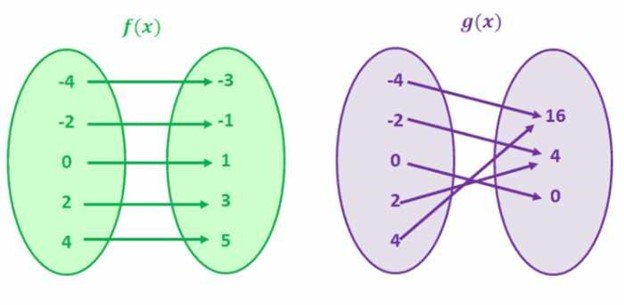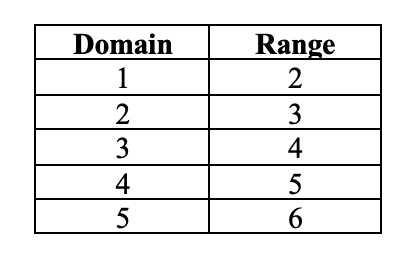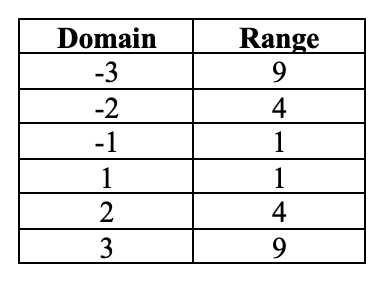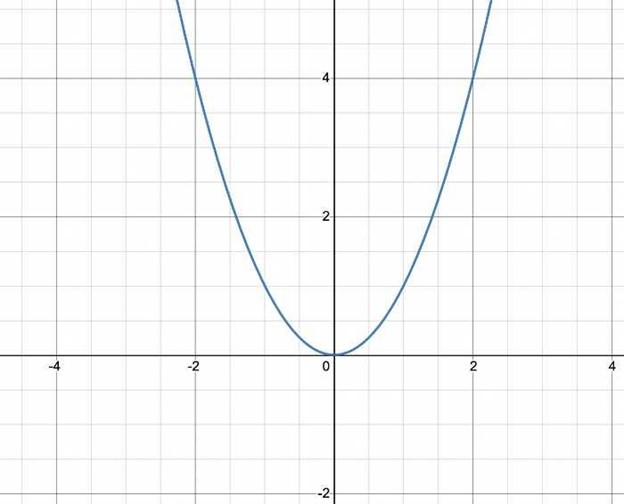One to One Functions - Graph, Examples | Horizontal Line Test
What is a One to One Function?
A one-to-one function is a mathematical function in which each input correlates to only one output. In other words, for each x, there is only one y and vice versa. This implies that the graph of a one-to-one function will never intersect.
The input value in a one-to-one function is known as the domain of the function, and the output value is the range of the function.
Let's examine the pictures below:

For f(x), every value in the left circle correlates to a unique value in the right circle. In conjunction, every value on the right side corresponds to a unique value on the left side. In mathematical terms, this signifies every domain holds a unique range, and every range owns a unique domain. Thus, this is a representation of a one-to-one function.
Here are some more examples of one-to-one functions:
-
f(x) = x + 1
-
f(x) = 2x
Now let's study the second example, which shows the values for g(x).
Be aware of the fact that the inputs in the left circle (domain) do not have unique outputs in the right circle (range). Case in point, the inputs -2 and 2 have identical output, in other words, 4. Similarly, the inputs -4 and 4 have identical output, i.e., 16. We can comprehend that there are matching Y values for numerous X values. Thus, this is not a one-to-one function.
Here are different representations of non one-to-one functions:
-
f(x) = x^2
-
f(x)=(x+2)^2
What are the characteristics of One to One Functions?
One-to-one functions have these properties:
-
The function holds an inverse.
-
The graph of the function is a line that does not intersect itself.
-
They pass the horizontal line test.
-
The graph of a function and its inverse are the same with respect to the line y = x.
How to Graph a One to One Function
When trying to graph a one-to-one function, you are required to determine the domain and range for the function. Let's study a simple representation of a function f(x) = x + 1.

Once you know the domain and the range for the function, you have to graph the domain values on the X-axis and range values on the Y-axis.
How can you evaluate whether or not a Function is One to One?
To indicate whether a function is one-to-one, we can leverage the horizontal line test. As soon as you graph the graph of a function, trace horizontal lines over the graph. In the event that a horizontal line passes through the graph of the function at more than one point, then the function is not one-to-one.
Due to the fact that the graph of every linear function is a straight line, and a horizontal line doesn’t intersect the graph at more than one spot, we can also reason that all linear functions are one-to-one functions. Don’t forget that we do not apply the vertical line test for one-to-one functions.
Let's study the graph for f(x) = x + 1. As soon as you chart the values for the x-coordinates and y-coordinates, you have to review if a horizontal line intersects the graph at more than one place. In this case, the graph does not intersect any horizontal line more than once. This signifies that the function is a one-to-one function.

Subsequently, if the function is not a one-to-one function, it will intersect the same horizontal line multiple times. Let's study the graph for the f(y) = y^2. Here are the domain and the range values for the function:

Here is the graph for the function:

In this case, the graph meets various horizontal lines. Case in point, for each domains -1 and 1, the range is 1. Additionally, for each -2 and 2, the range is 4. This means that f(x) = x^2 is not a one-to-one function.
What is the opposite of a One-to-One Function?
Considering the fact that a one-to-one function has only one input value for each output value, the inverse of a one-to-one function is also a one-to-one function. The opposite of the function essentially undoes the function.
For example, in the event of f(x) = x + 1, we add 1 to each value of x as a means of getting the output, in other words, y. The opposite of this function will subtract 1 from each value of y.
The inverse of the function is f−1.
What are the properties of the inverse of a One to One Function?
The characteristics of an inverse one-to-one function are identical to all other one-to-one functions. This implies that the opposite of a one-to-one function will have one domain for each range and pass the horizontal line test.
How do you figure out the inverse of a One-to-One Function?
Determining the inverse of a function is very easy. You simply have to change the x and y values. For example, the inverse of the function f(x) = x + 5 is f-1(x) = x - 5.

Just like we discussed before, the inverse of a one-to-one function undoes the function. Considering the original output value required us to add 5 to each input value, the new output value will require us to delete 5 from each input value.
One to One Function Practice Examples
Consider these functions:
-
f(x) = x + 1
-
f(x) = 2x
-
f(x) = x2
-
f(x) = 3x - 2
-
f(x) = |x|
-
g(x) = 2x + 1
-
h(x) = x/2 - 1
-
j(x) = √x
-
k(x) = (x + 2)/(x - 2)
-
l(x) = 3√x
-
m(x) = 5 - x
For any of these functions:
1. Determine whether or not the function is one-to-one.
2. Graph the function and its inverse.
3. Find the inverse of the function mathematically.
4. State the domain and range of both the function and its inverse.
5. Use the inverse to determine the value for x in each equation.
Grade Potential Can Help You Master You Functions
If you are struggling trying to learn one-to-one functions or similar functions, Grade Potential can put you in contact with a 1:1 tutor who can support you. Our Miami math tutors are experienced educators who support students just like you improve their understanding of these subjects.
With Grade Potential, you can work at your individual pace from the comfort of your own home. Plan a meeting with Grade Potential today by calling (305) 846-7424 to learn more about our educational services. One of our team members will get in touch with you to better ask about your needs to find the best instructor for you!




